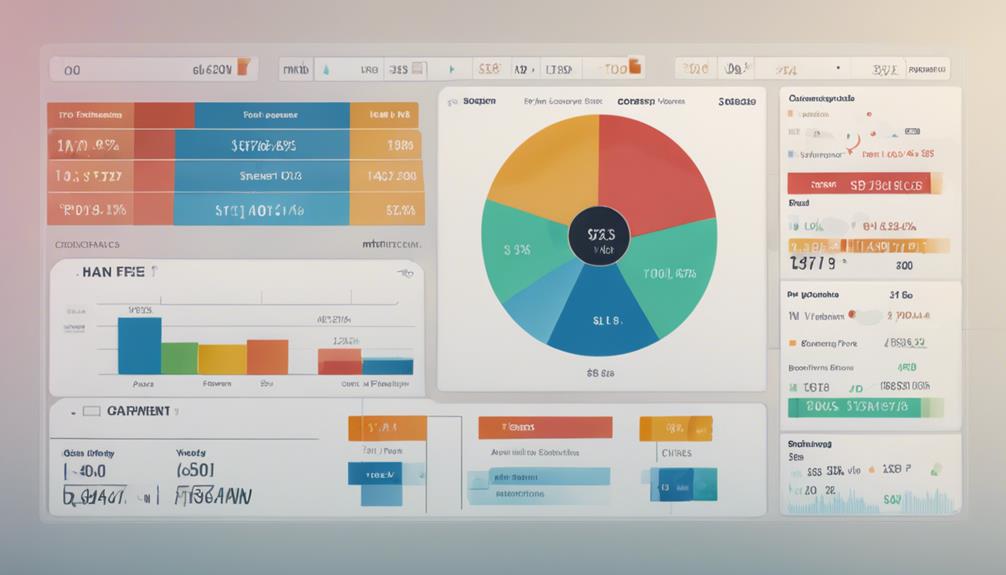To optimize your payment provider's performance, focus on tracking key metrics. Monitor transaction volume, payment success rates, customer conversions, risk management, cost efficiency, customer lifetime value, business growth, and payment processing reliability. Analyzing these metrics will help you make informed decisions, enhance customer experience, prevent fraud, and boost revenue. Your strategies can be fine-tuned for better efficiency and growth. Each metric plays a crucial role in the success of your payment provider. Understanding and acting on these indicators will lead to improved outcomes and sustained growth in the competitive payment industry.
Key Takeaways
- Transaction Volume and Trends for sales forecasting and resource allocation.
- Payment Success Rate Analysis to optimize system performance and prevent fraud.
- Customer Conversion Metrics to improve checkout process and increase revenue.
- Risk Management and Fraud Prevention to detect and address fraud activities.
- Cost Efficiency and Optimization for processing cost savings and system efficiency.
Transaction Volume and Trends

When evaluating the health and growth of a payment processing system, monitoring transaction volume is essential for understanding payment activity trends and patterns. Transaction volume, a key metric in payment processing KPIs, provides valuable insights into business performance and aids in forecasting future sales volumes. By analyzing transaction trends, businesses can adapt their strategies to optimize operations and enhance customer experiences.
Monitoring transaction volume is vital for identifying seasonality effects on payment processing. Recognizing these patterns allows businesses to prepare for fluctuations in transaction volumes, ensuring seamless operations during peak periods. Understanding transaction volume trends enables businesses to make informed decisions regarding resource allocation and infrastructure scalability.
Payment Success Rate Analysis

To further understand and optimize your payment processing system, analyzing the payment success rate is essential. The payment success rate is a critical Key Performance Indicator (KPI) that measures the percentage of successful transactions processed by your payment provider. It directly reflects the reliability and efficiency of your payment processing system. Monitoring this rate is vital as it helps in identifying technical issues, potential fraud attempts, and overall system performance. A high payment success rate guarantees a smooth payment experience for your customers, enhancing their satisfaction with your services. On the other hand, a low payment success rate may indicate the need for improvements in your payment processing infrastructure to boost performance and reliability. Below is a table summarizing the importance of payment success rate analysis:
| Importance of Payment Success Rate Analysis | ||
|---|---|---|
| Enhances Customer Satisfaction | Identifies Technical Issues | Improves Payment Processing Performance |
Customer Conversion Metrics

Optimize your payment process by tracking customer conversion metrics to evaluate the effectiveness of turning users into customers. Customer conversion metrics are essential in understanding how successful your sales funnel is at converting leads into paying customers.
By analyzing the conversion rate, which measures the percentage of completed desired actions, you can pinpoint any bottlenecks in the checkout process. This insight enables you to make informed decisions to enhance your pricing strategies and upselling techniques, ultimately driving revenue growth.
Monitoring customer conversion metrics also involves keeping a close eye on the average order value. Understanding this metric helps identify opportunities to increase revenue by encouraging customers to spend more per transaction.
Risk Management and Fraud Prevention

Enhance your business's financial security by vigilantly monitoring chargeback rates to detect potential fraud activities and disputes as part of your thorough risk management and fraud prevention strategy. To effectively manage risk factors and prevent fraudulent activities, consider the following key metrics:
- Track Fraud Rates: Keep a close eye on your fraud rates to evaluate the effectiveness of your fraud prevention measures. A sudden spike in fraud rates could indicate vulnerabilities in your system that need immediate attention.
- Analyze Risk Factors: By analyzing various risk factors associated with payment processing, you can proactively identify and address potential risks before they escalate. Understanding these factors can help you implement targeted prevention strategies.
- Monitor Alert Handling Status: Make sure that your team promptly responds to potential fraud alerts by monitoring the alert handling status. Timely responses can greatly reduce the impact of fraudulent activities on your business.
Cost Efficiency and Optimization

To enhance your payment provider's efficiency, begin by evaluating processing costs per payment method to pinpoint areas for optimization.
Analyze refund and chargeback expenses closely to develop effective cost-saving strategies.
Cost-Saving Strategies
By analyzing processing costs per payment method, you can identify effective cost-saving strategies within your payment provider metrics. To enhance cost efficiency and optimization, consider the following:
- Evaluate the cost of refunds and chargebacks to pinpoint areas where expenses can be reduced.
- Define chargeback representation strategies to mitigate the impact of disputes and lower associated costs.
- Assess processing costs per user to streamline payment processing efficiency and identify opportunities for optimization.
Implementing these strategies will help you optimize your payment systems and reduce overall processing costs, ultimately improving your bottom line.
Performance Analysis
Analyzing processing costs per payment method helps businesses identify and implement cost-effective strategies for performance analysis in their payment provider metrics. By evaluating the cost of refunds and chargebacks, companies can minimize financial losses and define chargeback representation strategies to reduce dispute-related expenses.
Evaluating processing costs per user allows tailored cost optimization measures, leading to improved cost efficiency. Optimizing payment systems with the right payment processing KPIs, such as conversion rates, successful transactions, authorization rates, and customer experience, is important.
Monitoring these metrics closely guarantees that businesses operate efficiently and provide a seamless payment experience for customers, ultimately boosting overall performance and financial sustainability.
Customer Lifetime Value Evaluation

When evaluating Customer Lifetime Value (CLV), it's essential to take into account various points such as:
- revenue forecasting methods
- churn rate analysis
- CLV growth strategies
By analyzing these factors, you can gain insights into how to maximize the value of each customer relationship.
Implementing strategies to increase CLV can lead to improved customer loyalty and sustained business growth over time.
Revenue Forecasting Methods
Estimating the revenue a customer will generate throughout their relationship with a business is essential for making informed decisions and maximizing profitability. By evaluating Customer Lifetime Value (CLV), businesses can predict future purchases, loyalty, and referrals to determine the long-term value of each customer. This analysis enables companies to tailor personalized offers, enhance customer experiences, and drive sustainable revenue growth.
To effectively forecast revenue and prioritize resources, consider the following methods:
- Use CLV evaluation to identify high-value customers and focus on building strong relationships with them.
- Leverage CLV insights to create personalized offers that resonate with individual customer needs and preferences.
- Enhance customer experiences based on CLV data, ensuring long-term satisfaction and loyalty.
Churn Rate Analysis
Understanding how churn rate analysis impacts the evaluation of customer lifetime value is essential for businesses seeking to optimize revenue and enhance customer loyalty. By measuring the rate at which customers discontinue using a service, businesses can gauge customer attrition and adjust retention strategies accordingly. Lower churn rates often correlate with higher customer satisfaction levels and long-term profitability. Analyzing churn rate trends allows businesses to identify the reasons behind customer attrition and implement targeted efforts to improve customer retention. This, in turn, can lead to increased customer loyalty and overall revenue growth. Utilizing churn rate analysis effectively is key to building a strong customer base and fostering lasting relationships with clients.
| Key Metrics | Impact on Business |
|---|---|
| Customer Lifetime Value | Helps predict revenue and assess customer loyalty |
| Revenue | Lower churn rates can lead to long-term profitability |
| Retention Strategies | Tailored efforts can be made to improve customer retention |
| Customer Satisfaction | Higher satisfaction often correlates with lower churn rates |
CLV Growth Strategies
To enhance your business's long-term profitability and customer loyalty, implementing effective CLV growth strategies is essential. Here are three key strategies to boost your customer lifetime value:
- Tailor Marketing Strategies: Utilize CLV insights to tailor personalized marketing strategies that resonate with high-value customers, increasing their engagement and loyalty.
- Enhance Customer Retention: Focus on retaining existing customers by offering exceptional service, personalized experiences, and incentives to encourage repeat purchases, thereby maximizing their lifetime value.
- Optimize Resource Allocation: Allocate resources effectively by prioritizing high-value customers identified through CLV analysis, ensuring that your efforts and investments are directed towards the most profitable customer segments.
Business Growth and Partnership Metrics

To effectively measure business growth and partnership success, track the number of new collaborations established each quarter. By monitoring this metric, you can gauge the expansion of your network and potential revenue streams. Additionally, assess the revenue generated from these partnerships to identify growth opportunities and evaluate the return on investment.
Measure the success rate of partnership programs in acquiring and retaining customers, as well as in enhancing brand visibility and market reach. Analyze the impact of partnerships on your overall business performance and compare costs against generated revenue to guarantee profitability.
Monitoring key payment metrics such as successful payments, payment performance, acceptance rate, credit card usage, and chargeback rates is vital in optimizing the payment experience for both your business and your partners. By focusing on these business growth and partnership metrics, you can drive strategic decisions and foster mutually beneficial collaborations.
Payment Processing Speed and Reliability

Achieving peak payment processing speed and reliability is paramount in today's digital landscape, where consumer expectations for seamless transactions continue to rise. To guarantee your payment processing meets the mark, consider the following key metrics:
- Speed is Essential: Research shows that 47% of consumers expect a webpage to load in 2 seconds or less. Slow payment processing can lead to a 7% decrease in conversion rates for every second of delay, impacting your bottom line greatly.
- Reliability is Vital: 79% of online shoppers won't return to a website if they experience performance issues. Reliable payment processing is essential for customer satisfaction, as 64% of shoppers are less likely to revisit a site after a bad experience.
- Boost Customer Loyalty: High-speed processing not only enhances customer satisfaction but also fosters loyalty. In fact, 52% of consumers cite fast checkout as a factor that would make them more likely to shop with a retailer again. Prioritizing speed and reliability in payment processing can hence significantly impact customer loyalty and conversion rates.
Frequently Asked Questions
What Are the Requirement Metrics of a Payment System?
To understand the requirement metrics of a payment system, focus on key aspects like:
- Cost of payments
- Churn rate
- Chargeback rates
- Fraud rates
- Purchase success rate
These metrics play an important role in:
- Evaluating performance
- Managing losses
- Maximizing revenue growth
- Ensuring system reliability
Monitoring churn, chargebacks, and fraud is essential for a healthy payment system, while purchase success rate measures the efficiency of payment processing in converting attempts into successful payments.
What Is a KPI in Payment?
A KPI in payment, or Key Performance Indicator, is a measurable value that showcases how effectively a payment provider is meeting key business goals. These indicators aid in monitoring and analyzing payment processes' performance, such as conversion rates, fraud rates, processing speed, and customer satisfaction.
What Are the 4 KPIS Every Manager Has to Use?
To manage effectively, you must track the following key performance indicators:
- Conversion Rate
- Payment Failure Rate
- Processing Speed
- Chargeback Rate
These metrics reflect different aspects of your payment processing system, including customer engagement, process optimization needs, transaction efficiency, and dispute impact. Monitoring these KPIs guides decision-making and enhances payment processing performance.
Keep a close eye on these key indicators for a successful payment processing strategy.
What Success Metrics Would You Use to Measure a Payment Gateway Product?
To measure the success of a payment gateway product, you'd focus on key metrics like conversion rates, payment failure rates, fraud rates, acceptance rates, and settlement times.
These metrics help evaluate the gateway's efficiency in turning visitors into customers, addressing transaction issues, ensuring security, processing transactions, and timely settlements for cash flow.
Monitoring these factors provides insights into the product's effectiveness and helps optimize its performance.
Conclusion
As you navigate the world of payment providers, remember to keep a close eye on key metrics that can make or break your business. From transaction volume to customer conversion rates, monitoring these indicators will help you steer your company towards success.
Just like a skilled captain relies on the stars to guide their ship safely through turbulent waters, monitoring these metrics will guarantee a smooth and steady course towards your business goals.
Keep vigilant, stay informed, and watch your business thrive.









